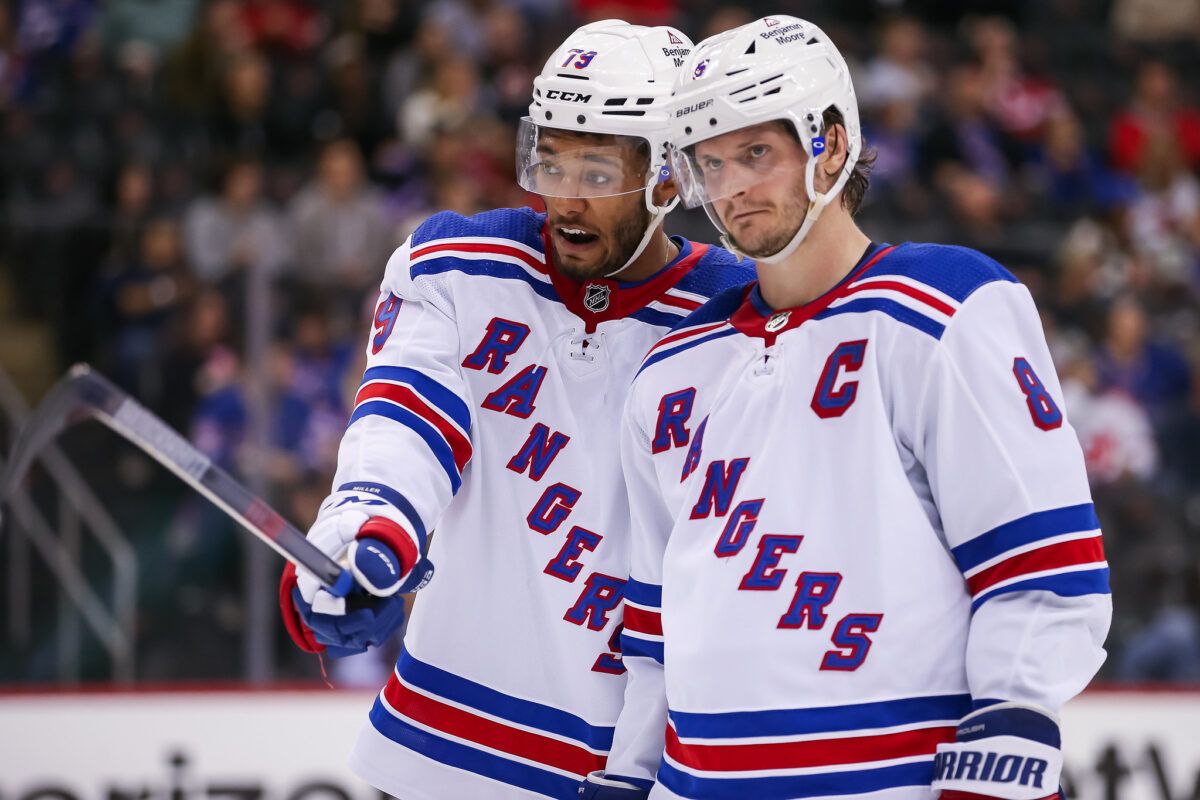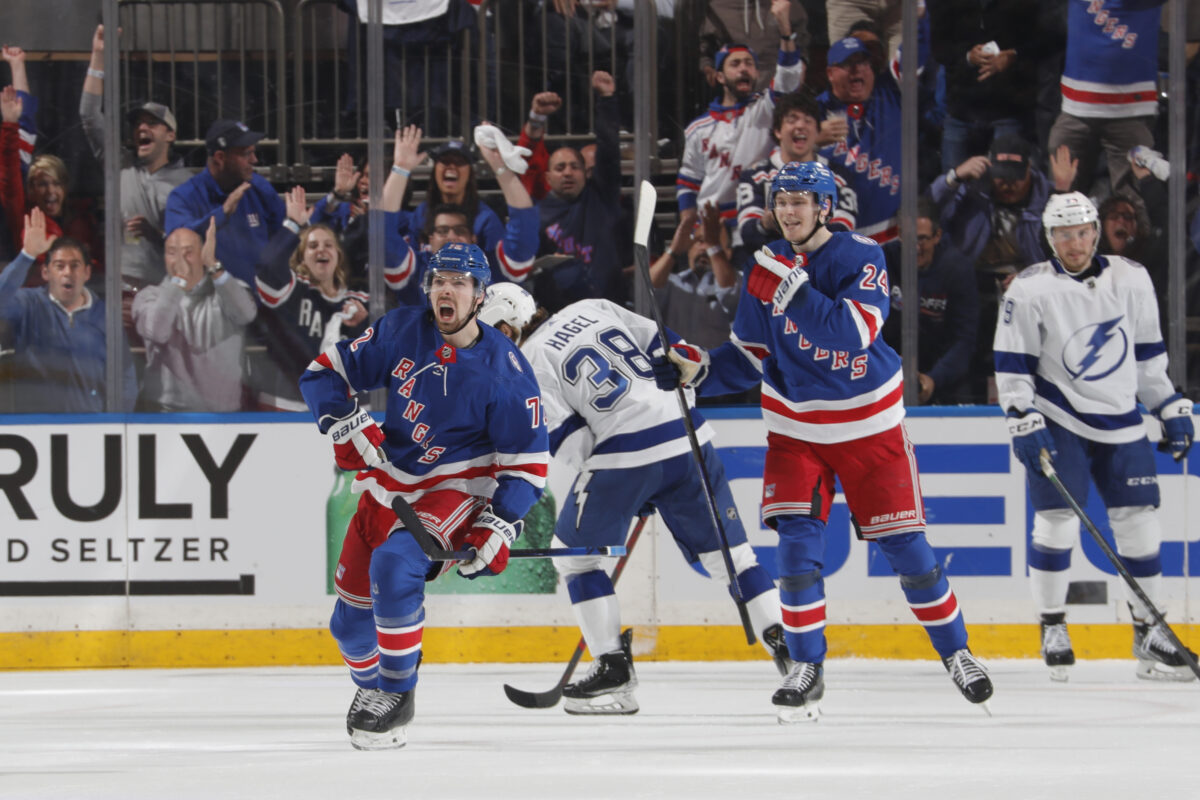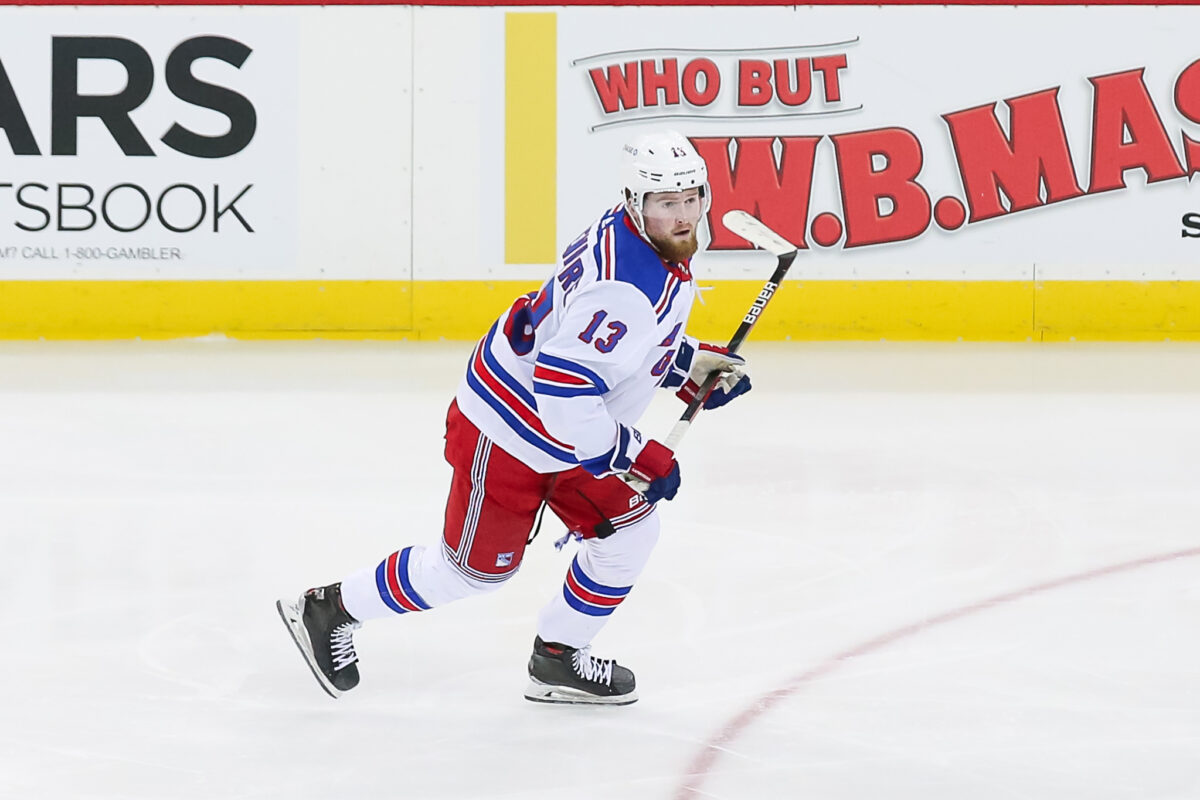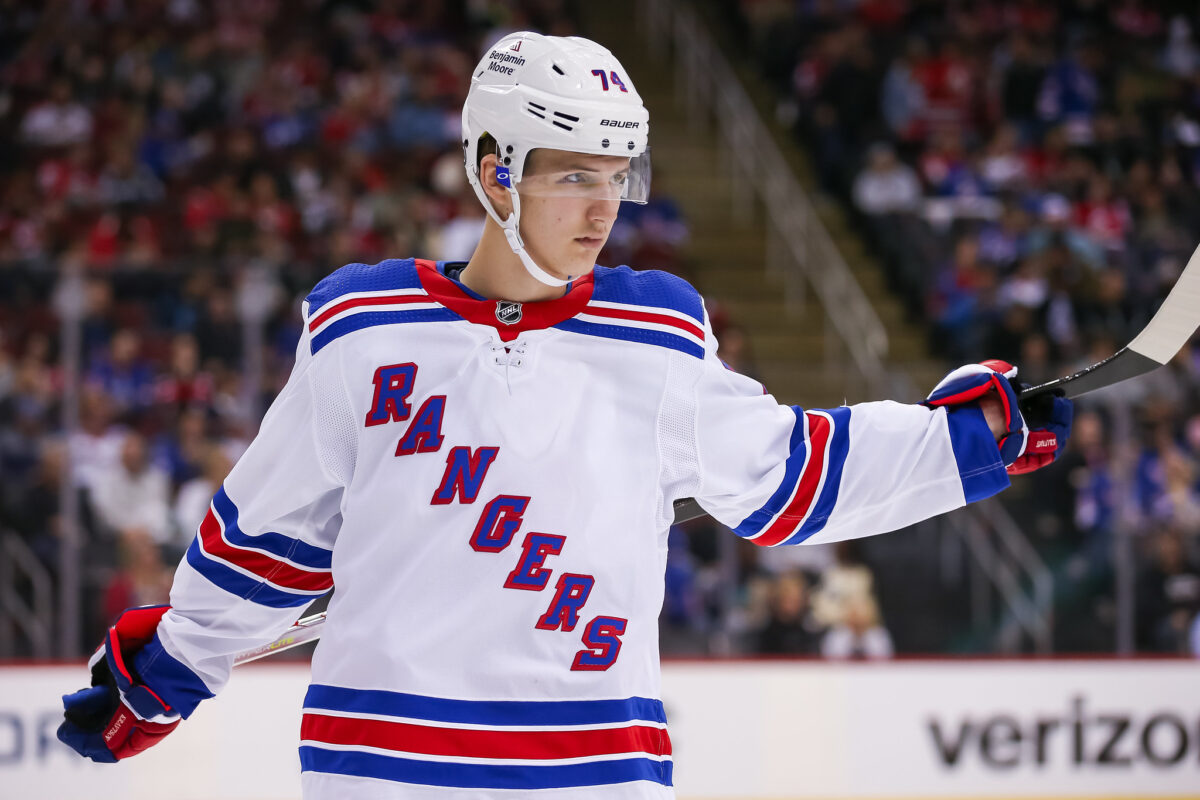The New York Rangers have been unable to maintain the magic of last season into 2022-23, struggling to hold leads, suffering from inconsistency and obviously lacking the confidence that carried them to within two wins of the Stanley Cup Final last spring. Surely, the time for serious soul-searching has arrived.
Well … perhaps. While the Rangers have failed to compile the gaudy early-season record they did a year ago, some of what’s happening now might be part of the often-painful, bumpy and winding road to consistent contention that plenty of eventual champions before them had to travel – and which can provide a clearer picture of what needs to change for them to take the next step further down that path.
At this time last year, the Blueshirts were 13-4-3, in the midst of a seven-game win streak that would move them to 17-4-3 and into prime position to reach the postseason. They went on to compile 110 points, second-most in the Metropolitan Division, and pushed the two-time defending champion Tampa Bay Lightning to six games in the Eastern Conference Final before falling.

Now 10-9-4 less than two months into 2022-23, little of that swagger is evident. The Rangers have watched bad periods result in excruciating lost leads, they don’t score with regularity and, in the wake of key offseason personnel defections, can’t seem to find lineup combinations that click. It’s left them in fifth place in the Metro and with plenty of work to do to get back to the playoffs.
No Lead Has Been Safe for These Rangers
The Blueshirts’ 5-3 home loss to the rampaging New Jersey Devils on Monday was ugly, the Rangers having gone up 2-0 just 3:01 into the game before being overwhelmed by their faster, deeper opponents. The defeat followed what was likely their worst loss of the season, 4-3 to the Edmonton Oilers on Saturday after carrying a 3-0 lead into the third period. The Rangers also blew a 3-1 lead in a loss to the New York Islanders on Nov. 8 and squandered a 2-0 advantage after one period in a 3-2 overtime defeat to the Detroit Red Wings two days before.
“We’ve got to turn it around,” coach Gerard Gallant said after Monday’s loss. “Tonight was a good night to try and turn it around with the team that we were playing: a young team but they play hard, they play fast. I wouldn’t say that they’re the surprise team of the year, but they look really good and they play hard.” (From ‘Rangers Blow Another Multi-Goal Lead In Alarming Loss to Devils’, New York Post, 11/28/22)

The Rangers were the surprise team of the year last season. Was that a fluke? Unlikely. What’s clear, though, is that these Rangers have taken a step back, and now need to work through the process of learning how to win again as they discover in the aftermath of their deep postseason run just how difficult it is to do so consistently.
While captain Jacob Trouba said after the Oilers defeat that the club had discussed before the season how opponents would play harder against them, it’s possible that there’s still an adjustment period going on. Knocking off a 110-point team from last season serves as a feather in the cap for most clubs at this point.
Perfect parallels for what’s happened so far in 2022-23 are difficult to come by. Every team is different. Yet a look at the past three Stanley Cup winners provides solid examples of how climbing the championship mountain takes years, and is often anything but a linear process. The Colorado Avalanche finally reached the pinnacle in 2021-22, emerging from a rebuild that saw them miss the playoffs for three straight seasons before making the postseason in 2017-18.
The Avs, though, lost in the first round that season and exited in the second each of the next three playoffs. Finally, with drafted-and-developed franchise cornerstones Nathan MacKinnon and Cale Makar leading the way, the Avs stormed to 119 points and their third Stanley Cup last season, defeating the Lightning in the final.
Tampa Bay rode a rollercoaster to its back-to-back championships that preceded Colorado’s Cup. The Lightning missed the tournament in five of six seasons after committing to a rebuild three years after winning their first championship in 2004 (their one playoff appearance in that time was a 2011 run to the conference finals). From 2013-14 through 2018-19, though, Tampa’s season results read this way: lost in the first round, lost in the Stanley Cup Final, lost in the conference finals, missed the playoffs, lost in the conference finals, lost in the first round. The next three seasons brought back-to-back titles and a Cup Final appearance.

Along the way, both teams learned the hard way what it took to succeed through the regular season and into the playoffs. The Lightning, in particular, got close again and again without finishing the job, while also suffering one of the most stunning postseason defeats in NHL postseason history – a 2019 sweep at the hands of Columbus Blue Jackets, who had compiled 30 fewer points than Tampa did that season.
Young Players Need to Be Given Bigger Roles, More Responsibility
Are the Rangers different? Like the Avs and Lightning, the Rangers used a full rebuild to secure high-end young talent, including top-of-the-draft selections Alexis Lafreniere and Kaapo Kakko who ostensibly represent part of their future core. And like those two teams, the Blueshirts discovered elite talent in other places, such as the trade for 2020-21 Norris Trophy winner Adam Fox and 2021-22 Vezina Trophy winner Igor Shesterkin, a fourth-round pick in 2014.
Therefore, there’s an argument to be made that the Rangers’ current problems, as bad as they look, might be at least somewhat natural, an organization walking the treacherous route toward perennial championship contention and of course, elusive Stanley Cups. While that’s tough for the fan base to accept, the recent histories of teams such as Tampa Bay and Colorado should in theory be a source of at least some comfort.

That doesn’t mean the Rangers shouldn’t be learning and adjusting along the way. There’s legitimate concern about the club’s development process for its young gems, most notably Lafreniere and Kakko, both of whom have failed to bust out since being drafted in 2020 and 2019, respectively. Shuttled between assignments on the “Kid Line” (which includes fellow slow-developing prodigy Filip Chytil) and the top two forward units, neither player has managed to do much more than flash their talents from time to time. Lafreniere and Kakko are just 21 years old and Chytil is 23, so it’s too early to assess their overall potential.
The big question now, though, is are the Blueshirts handling these crucial early years correctly for all three players? Add to that concern over Shesterkin, who turned in a historically good season in 2021-22 but has been as shaky as his team this season and struggled badly against the Devils.
Mixed messages and uncertain goals coming from behind the bench and the executive suite probably aren’t helping. The Rangers appear stuck between trying to match last season’s results and properly developing their kids, uncertainty that seems to be manifesting itself in often-confusing lineup decisions. A glaring example is that of winger Vitali Kravtsov, the ninth overall pick in 2018 whose long saga led him back to Broadway for 2022-23, but who can’t seem to get back into the lineup after a series of injuries that sabotaged his chances to stick as a regular early on.
Kravtsov is healthy now, yet was scratched again Monday, though he’s set to finally be reinserted for Wednesday’s matchup with the Ottawa Senators. Coach Gerard Gallant, who pushed all the right buttons last season, has been less successful in 2022-23, seemingly more intent on giving grinders like Barclay Goodrow and Jimmy Vesey top-six assignments over Lafreniere, Kakko, Chytil and obviously Kravtsov.

It’s somewhat puzzling, but perhaps not as much so when taking into account the effect of last season’s conference finals appearance. The rebuild seemed to be over, the Rangers ready to start competing again after a four-year process of tearing it down and building back up.
Deep Playoff Run Might be Hurting Rangers This Season
That’s why the surprising postseason surge could prove to be a curse as well as a blessing. Beyond the high-end veterans on the roster, these Rangers remain young, still in the growth process as they learn how to be consistent pros.
For it is team management that saw an opportunity to compete while the kids learned, to provide cover and keep pressure off the talented youngsters so as not to burden them with too much responsibility too soon. The 2019 signing of forward Artemi Panarin was followed by the extending of career Ranger Chris Kreider in February 2020, forming along with No. 1 center Mika Zibanejad the veteran triumvirate which would lead the way for a talented but inexperienced group.
While the Rangers’ course of action then is one almost any team would have followed – Panarin, one of the best offensive players in the league, wanted Broadway, while Kreider was simply too much of a commodity to let escape – it’s possible that the presence of in-their-prime stars may be hampering the youth. For instance, it’s become abundantly clear that Lafreniere is more comfortable on his natural left wing, having had difficulty adjusting to the right when the club has tried him there.
Related: Rangers’ Kakko Being Surpassed by 2019 Draft Classmates
The top two left-side spots, however, are locked down by Kreider and Panarin for the long term. Is playing the two vets ahead of the team’s supposed future top left wing what’s best for the organization at this point?
While Gallant wants young players to earn their ice time, that’s difficult to do when Lafreniere and Kakko keep bouncing between the third line and the top two, and Kravtsov can’t get into the lineup at all. Gallant’s policy of keeping the young forwards off the top power-play unit for the past two seasons also limits their chances to gain confidence.

There’s a big difference between handing a player a job and giving him time and opportunity to grow when presented with more responsibility. That was brutally apparent Monday as the youthful Devils, whose highly-regarded kids were afforded patience through their growing pains, again served notice that they had arrived.
The Rangers have regressed after a wholly unexpected playoff result in 2021-22. Shesterkin hasn’t been able to cover over defensive lapses like he did last season. Rather than panic, Gallant and the organization need to draw lessons from what’s happening – ideally, how a course correction that re-emphasizes the supposed future of the team is what’s necessary, and how the rebuild, as much as the Rangers would like to put it in the rearview mirror, isn’t over.
